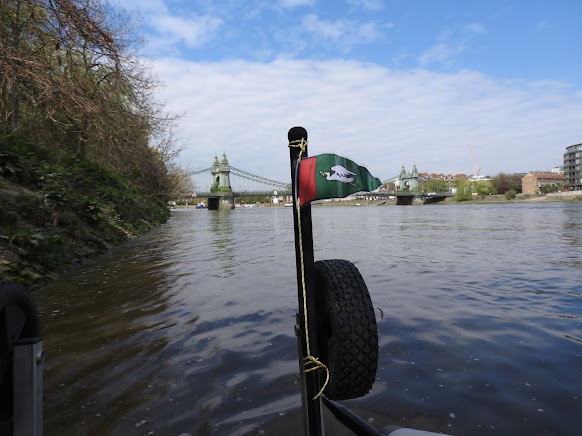When I got near the bridge the tide was strengthening along the bank and I realised it would be difficult to go back against it. I had to find the steps or I would be in danger of drifting under the bridge. I turned the inflatable to face upstream and drifted carefully upstream with the tide.
Going backwards towards the Hammersmith Bridge and flying the flag of my sailing club, Mengeham Rythe, in Chichester Harbour
As was doing getting closer, the crew of a Sea Dog catamaran started shouting at me. All they could see was an inflatable dinghy without power drifting down towards the bridge.
Initially, because they could not hear my explanation they got more frantic. So I took out my portable radio and waved it at them. One of the crew held up both hands with fingers splayed and I realised he was indicating Channel 10. They asked my intentions, and seemed satisfied when when I explained my plan.
This all distracted me from finding the steps, but they appeared suddenly ahead. They were caked in soft mud at the bottom. With some difficulty I was able to lean over the side of the inflatable and get enough friction between my hand and the steps to hold the inflatable in place.
I then gingerly got onto the steps and I climbed them, pulling the inflatable out of the water using an attached rope. It was hard going and I was determined not to slip or lose my balance.
Just stabilised on the river bank
Looking back down
I then deployed the inflatable transom wheels and used further wheels at the bow to make pulling it along easier. The towpath was smoother round the other side of the bridge.
The bank was too steep to risk lowering it back down some further steps. Instead, I trundled the inflatable along the tow path until I reached the St Pauls School slipway.
There was some delay as school crews were launching, but I enjoyed talking to the boatman who seemed to understand immediately I was doing a charity event and told me that he would like to do something similar on a paddleboard.
In a gap between the school crews launching I set off and was soon was at Barnes Bridge, at the infamous site of the Cambridge Boat Race crew sinking in 1977, the year I rowed for the Oxford lightweight crew.
Chiswick Bridge was then around the corner and I finished at the Tideway Scullers boathouse.
It had taken over an hour and half to row the Boat Race Course in an inflatable, compared to the 16 to 18 minutes it takes the Oxford or Cambridge crews.





















